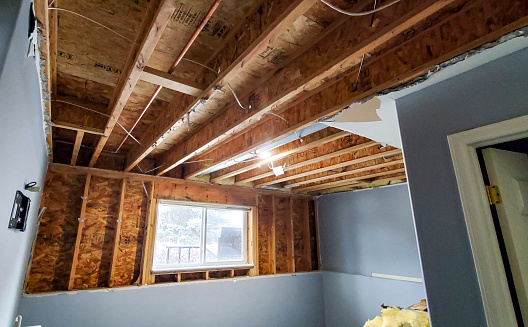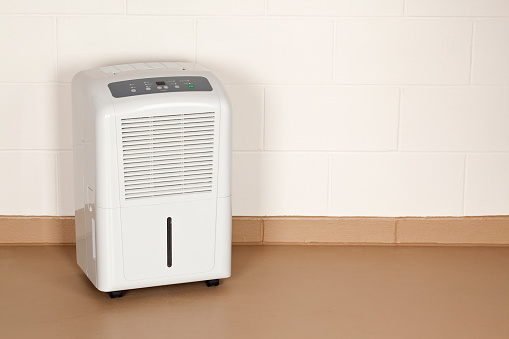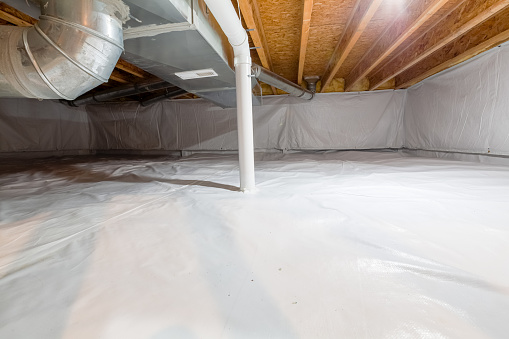With the advent of autumn comes the end of summer heat and humidity. As we transition into cooler temperatures, many homeowners begin to prepare their homes for the winter months ahead. One often overlooked area is the crawl space.
Crawl spaces are commonly found in homes with a basement or slab foundation and are typically unfinished. These areas can be breeding grounds for mold, mildew, and other harmful bacteria if not properly ventilated and maintained.
High humidity levels in the crawl space can also lead to wood rot, structural damage, and an increased risk of insect infestation. This guide will discuss the importance of crawl space humidity, how to identify potential problems, and what you can do to mitigate them. Let’s get started.
What Is Crawl Space Humidity?
Crawl space humidity is the amount of moisture present in the air of your crawl space. The ideal crawl space humidity level is between 30% and 50%. However, many homes have crawl spaces with relative humidity levels above 60%. High crawl space humidity levels can lead to various problems, and it is important to reduce humidity levels in your crawl space.
Also, it’s not only the relative humidity that should be of concern but also the actual crawl space moisture content of the air. The dew point measures how much water vapor is present in the air and is a good indicator of whether or not condensation will occur. The dew point is the temperature at which water vapor in the air condenses into water droplets.
If the crawl space air temperature is below the dew point, then condensation will occur on surfaces in the crawl space, such as on pipes, ductwork, or floor joists. This can lead to mold growth, wood rot, and other problems.
Reasons Your Crawl Space Is Humid
Several things can cause high humidity levels in your crawl space, most of which have to do with its design or lack thereof. Here are some common reasons for elevated moisture:
1. Poorly Placed Or Missing Vapor Barrier
If there’s no vapor barrier (plastic sheeting) on the ground, moisture will seep through the soil and into your crawl space. If the vapor barrier is old, damaged, or poorly placed (i.e., not covering the entire ground), it will also allow moisture to enter. Also, if there are any holes or cracks in the foundation walls, moisture will seep through them as well.
2. Leaking Or Condensing Pipes
If there are exposed pipes in your crawl space and they’re leaking, that’s going to raise the humidity levels. But even if they’re not leaking, they can still cause problems. Cold water pipes often “sweat” in humid conditions, condensing water droplets drip down and pool on the ground (or wherever else they land).
3. Poor Ventilation
If your crawl space is poorly ventilated, that means hot, moist air from outside can’t escape, and the humid air will get trapped. This is especially common in older homes where the crawl space vents may be blocked by insulation or other materials. While you want to keep the outside air out, you also need a way to escape the inside air or excess moisture.
4. Groundwater Flooding
If your crawl space is located in an area with a high water table, groundwater can seep up and flood the space. This is a major problem requiring professional help, but it’s important to be aware of it if you live in a flood-prone area.
5. Humid Climates
Suppose you live in an area with high humidity (like the southeastern United States). In that case, that will contribute to elevated moisture levels in your crawl space, even if everything else is properly sealed and ventilated.

Effects Of High Crawl Space Humidity Levels
Numerous impacts are associated with high levels of humidity in the crawl space. These impacts range from common issues, such as an increased likelihood of developing mold, to potentially more serious problems, such as poor indoor air quality and wood rot.
- Mold And Mildew: With relative humidity of more than 70%, mold and mildew can grow on wood, paper, insulation, and carpet. The spores emitted from these fungi can cause serious health problems for those with allergies or respiratory sensitivities.
- Indoor Air Quality: If the relative humidity in your home is high, the air feels muggy and sticky. This happens because the air is holding more moisture than it can comfortably contain, and as a result, the air feels warmer than it is. In addition, high humidity can cause condensation on windows and crawl space walls, leading to mold and mildew growth.
- Wood Rot: Wood rot is caused by a combination of moisture and warm temperatures. When wood rot occurs, the wood will become soft, brittle, and crumbly. In extreme cases, wood rot can cause structural damage to your home.
- Crawl Space Odor: High humidity in the crawl space can cause musty odors that can be difficult to remove. In addition, musty odors can lead to headaches, nausea, and respiratory problems.
- Pest Infestation: High levels of humidity can attract a variety of pests, such as beetles, cockroaches, and termites. These pests can damage your home and put your family at risk for diseases.
- Water Damage: Water damage is one of the most common problems associated with high humidity for homes with a crawl space. Water leaks into the crawl space can cause mold growth, wood rot, and structural damage.
How To Lower Crawl Space Humidity Level
Several solutions can help to lower crawl space humidity. They include:
1. Improve Ventilation
Improving ventilation is one of the most effective ways to lower crawl space humidity. Increasing the airflow in the crawl space can help remove the moist air that leads to high humidity levels. There are a few different ways that you can improve ventilation in your crawl space:
- Open Or Enlarge Vents: If your crawl space already has vents, you may be able to improve the airflow by simply opening or enlarging them. This will allow more air to flow into the space and help to remove the humid air.
- Add Additional Vents: If your crawl space has no vents, you can add them. This will help increase the airflow and lower the humidity levels.
- Install A Vent Fan: Another option is to install a vent fan in the crawl space. This will help to force the air out of the space and lower the humidity levels.
2. Use a Dehumidifier
Using a dehumidifier is an effective way to reduce the humidity levels in your crawl space. This will help to prevent the growth of mold and mildew and also help to reduce the musty smell that can often accompany high humidity levels.
Investing in a quality dehumidifier is important, as some models are better at reducing humidity levels than others. Ensure that the unit is the right size for your crawl space, as an undersized unit will not be as effective. Also, ensure to empty the water reservoir regularly, as this can become full quickly in a humid environment.

3. Crawl Space Encapsulation
Crawl space encapsulation is another effective solution for reducing crawl space humidity. This involves sealing the crawl space so that humid air cannot enter. This can be done by sealing the vents, doors, and other openings with a moisture barrier.
With 10 to 20 mil polyethylene sheeting, seal off the crawl space vents. This will create an airtight and watertight seal that will prevent humid air from entering the space. Also, seal any cracks or openings in the foundation with hydraulic cement. This will help to prevent moisture from seeping into the crawl space.
While crawl space encapsulation is an effective solution for reducing humidity, it is important to note that it should only be done by a professional. Attempting to do it yourself can lead to serious problems if it is not done properly.

4. Install A Sump Pump
A sump pump is a device that is installed in the lowest part of your crawl space. Its function is to remove any excess water accumulated in this area. A sump pump can be a lifesaver if you live in an area prone to flooding or have a high water table. It can also help to prevent mold and mildew from growing in your crawl space.
Dealing with heavy precipitation or water leaks will require a sump pump with higher horsepower. You will want at least a 1/3 horsepower sump pump, but ½ or ¾ horsepower would be even better. If you live in an area prone to flooding, you may consider investing in a battery-operated backup sump pump. This will ensure your crawl space stays dry even if the power goes out.

5. Use A Humidity Monitor
A humidity monitor is a device that measures the moisture content in the air. This can be a useful tool in helping you to keep track of the humidity levels in your crawl space. If you notice the levels rising, you can take action to lower them before they become a problem.
For example, suppose you notice the humidity levels in your crawl space rising. In that case, you can take steps to improve ventilation or use a dehumidifier to remove the excess moisture from the air.
FAQs
1. Is It Essential To Dehumidify A Crawl Space?
While it is not essential to dehumidify a crawl space, doing so can create a healthier and more comfortable environment in your home. Reducing the humidity in your crawl space can help prevent mold and mildew growth, which can cause serious health problems. Also, by reducing the humidity in your home, you can help improve the air quality and make it more comfortable to live in.
2. Can I Use A Dehumidifier In My Crawl Space?
Yes, you can use a dehumidifier in your crawl space. It is one of the most effective ways to reduce the humidity in your crawl space. Dehumidifiers work by removing moisture from the air, which can help to reduce the humidity in your home. Be sure to choose a dehumidifier that is the right size for your crawl space so that it can effectively remove moisture.
3. Can Humidity Damage My Home?
Yes, high humidity levels can damage your home. High humidity can cause wood to warp and rot, paint peel, and metal rust. Also, high humidity can encourage the growth of mold and mildew, which can cause serious health problems. Therefore, keeping the humidity in your home at an appropriate level is important.
Be sure to check out our other essential crawl space guides.
Conclusion
With all this being said, taking action is important if you think your home may have a crawl space humidity problem. If you let the problem persist, it can lead to much more serious issues down the road – including mold growth and wood rot.
Encapsulate your crawl space, use a dehumidifier, and ensure your vents are clear and functioning properly. These simple solutions can make a big difference in the long run.
If you’re unsure where to start or what to do, contact a professional for help. They’ll be able to assess the situation and recommend the best course of action for your home.


